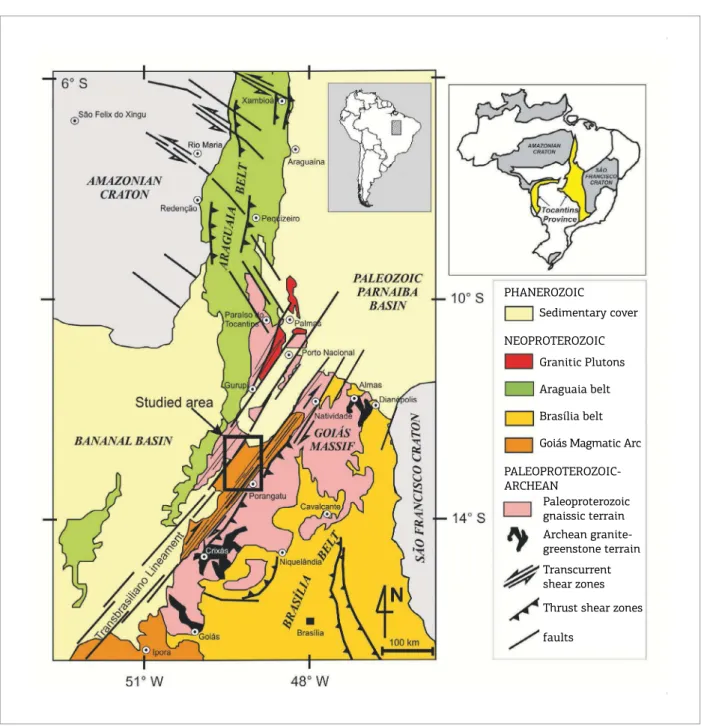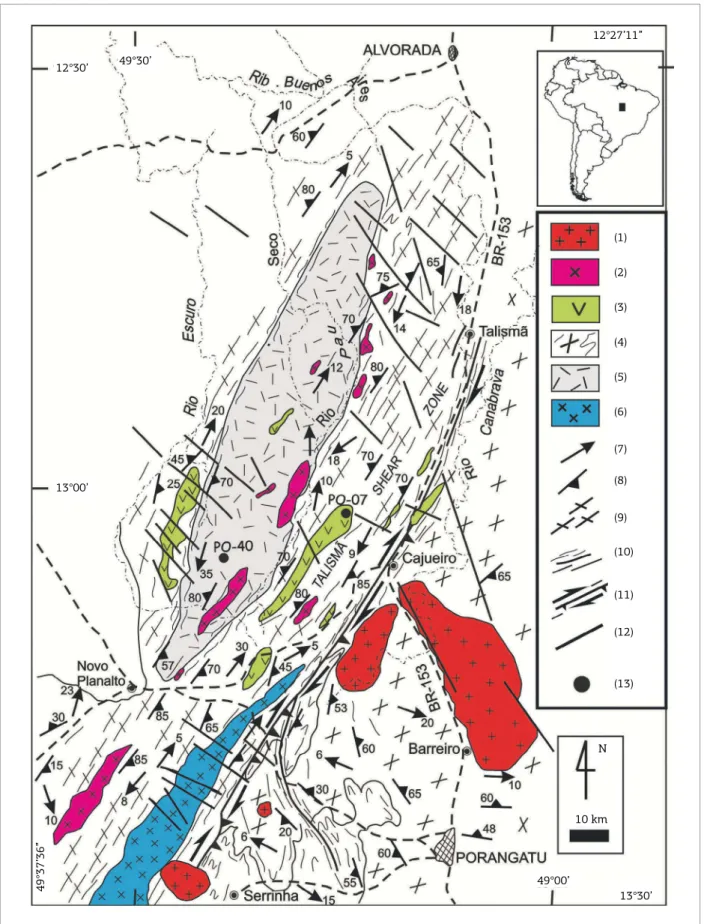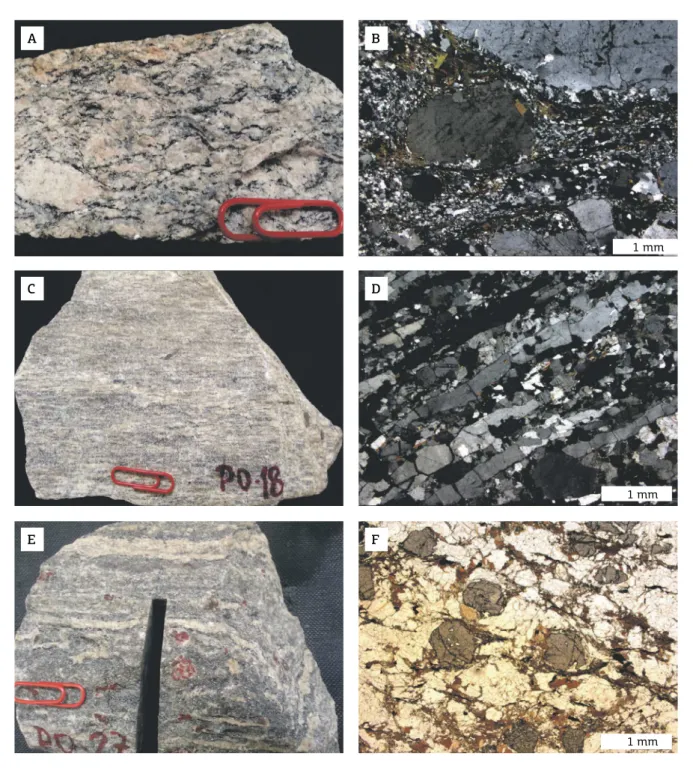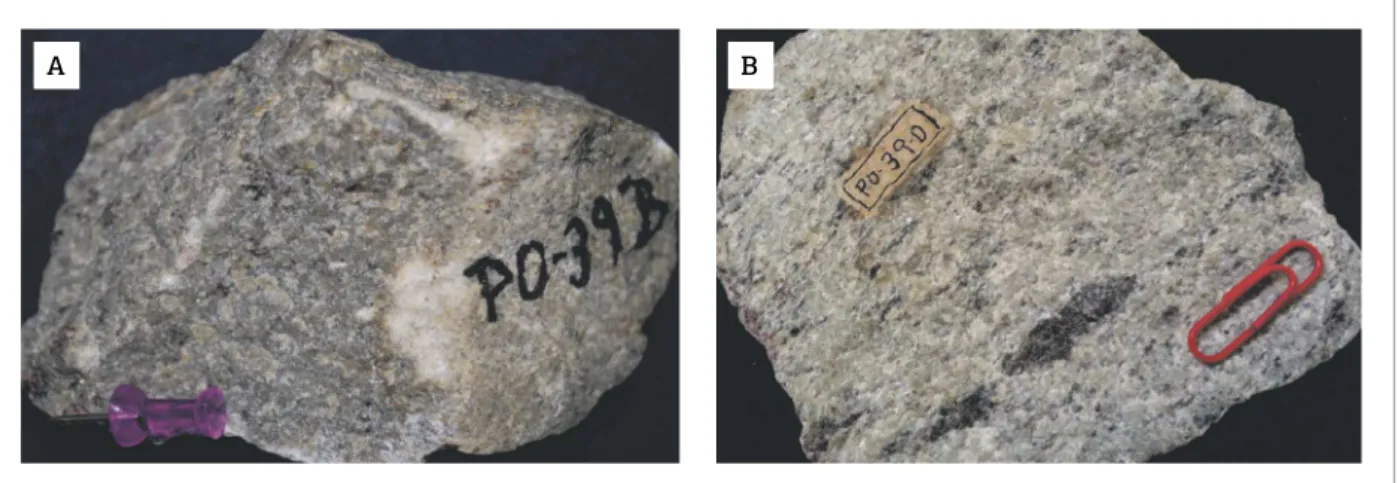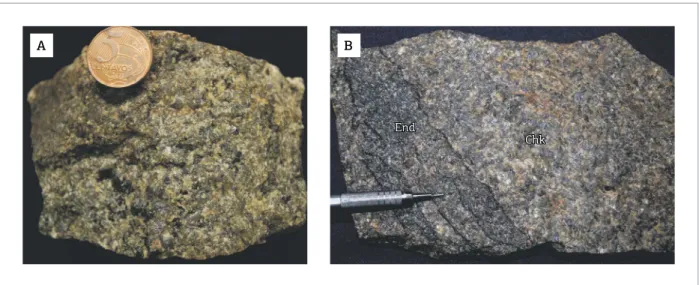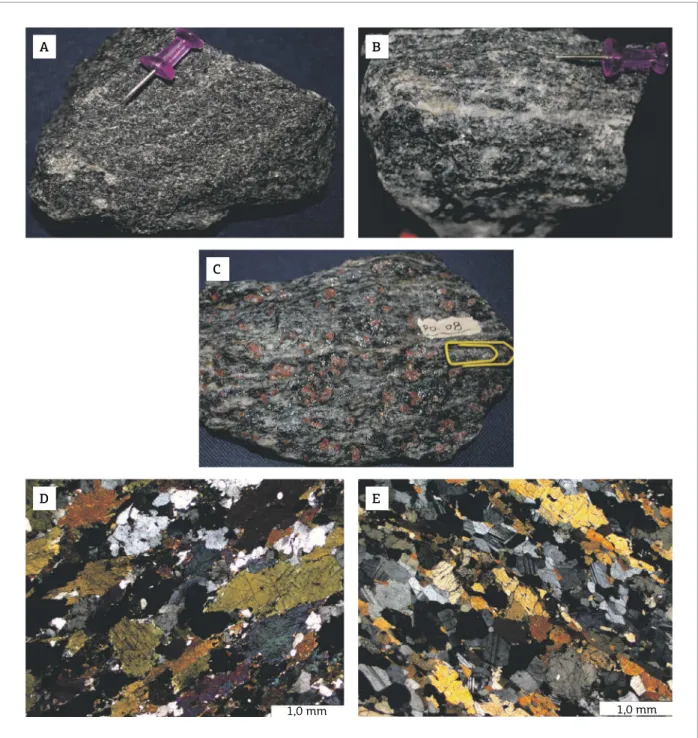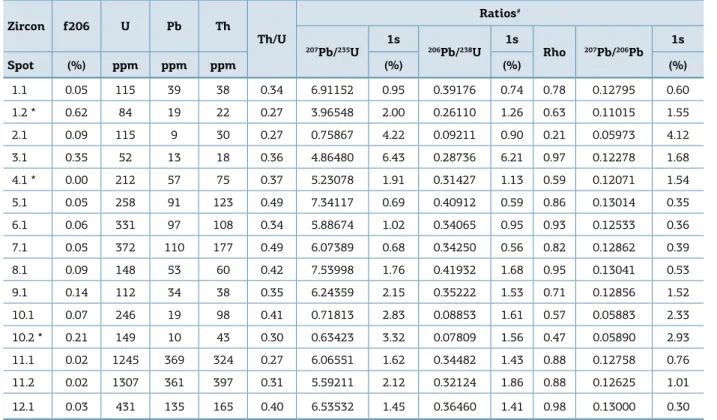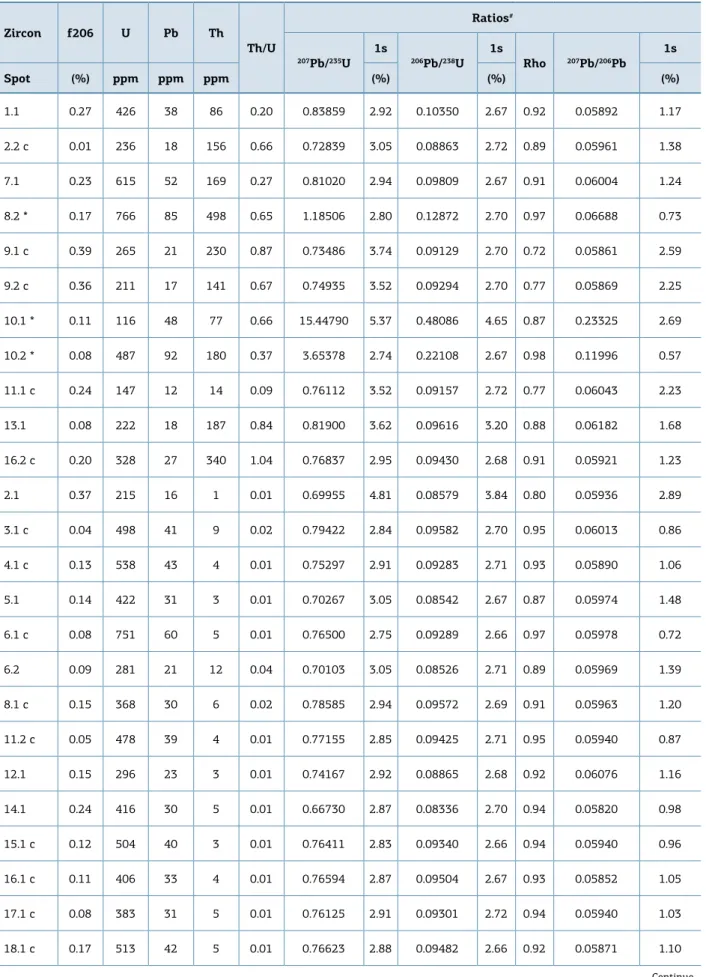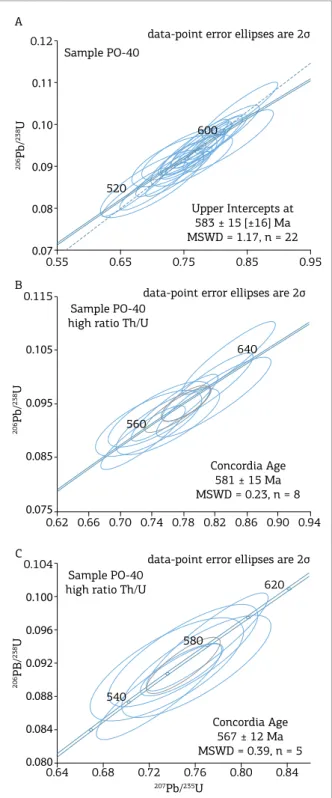1Instituto de Geociências, Universidade Federal do Pará – UFPA, Belém (PA), Brazil. E-mails: gorayebp@ufpa.br; antogt@ufpa.br 2Instituto de Geociências, Universidade de Brasília – UnB, Brasília (DF), Brazil.E-mail: marcio@unb.br
3Research School of Earth Science, Australian National University – Canberra, Australia. E-mail: richard.armstrong@anu.edu.au
*Corresponding author.
Manuscript ID: 20160097. Received in: 08/12/2016. Approved in: 03/27/2017. ABSTRACT: he Porangatu Granulite Complex is exposed in the central part of the Neoproterozoic Tocantins province in cen-tral Brazil, along the boundary between the Brasília Belt to the east and the Araguaia Belt to the west. his is part of the transconti-nental Transbrasiliano-Kandi shear system. he complex includes garnet-rich enderbite and charnockite, high-grade gneisses as well as lenses of garnet-bearing maic granulite or amphibolites, and in situ anatectic charnockite, elongated in the NNE-SSW direction along the Talismã Shear Zone (TSZ). hese rocks represent suites of ortho-derived rocks of calc-alkaline ainity and small contribu-tions of tholeiitic basalts and aluminous paragneisses. he structural framework records thrust components probably related to the early stages of an oblique collision during the evolution of Neoprotero-zoic Brasiliano orogens, and can be understood as involving a colli-sional system of two crustal blocks, initially with thrust components which in its inal stage evolved to a transcurrent system with dextral movement. his led to intense imbrication, generation of mylonit-ic foliation, stretching lineation, tectonmylonit-ic banding and rotation of structures and minerals. he heterogeneous and progressive ductile deformation was accompanied by metamorphic re-equilibrium in late Neoproterozoic time. Granulite facies conditions reached a met-amorphic maximum at temperature and pressure above 850°C and 10 kbar, in an almost anhydrous environment, with or without ana-texis. Zircon U-Pb SHRIMP analyses for two selected rock samples indicated the combined age of 580 ± 7 Ma for a charnockite and 548 ± 48 Ma for a maic granulite from which the charnockite is throught to have been derived. he maic granulite contains zircon grains of ca. 2.1 Ga, indicating Paleoproterozoic igneous protoliths involved in Neoproterozoic high-grade metamorphism. In addi-tion, older inherited zircon grains of ca. 3.1 and 2.0 Ga (207Pb/206Pb
RESUMO: O Complexo Granulítico Porangatu está exposto na porção central da Província Tocantins, do Neoproterozoico, no centro do Brasil, ao longo da fronteira entre o Cinturão Brasília, a leste, e o Cinturão Ara-guaia, a oeste. Esta região faz parte do sistema de cisalhamento transconti-nental Transbrasiliano-Kandi. O complexo inclui enderbitos e charnocki-tos ricos em granada, gnaisses de alto grau metamórico, bem como lentes de granada granulitos máicos ou granada anibolitos, e charnockitos ana-téticos in situ, o qual forma corpos alongados na direção NNE-SSW, ao longo da Zona de Cisalhamento Talismã (ZCT). Esse conjunto de rochas representam suítes de rochas ortoderivadas de ainidade cálcio-alcalina e pequenas contribuições de basaltos tholeíticos e paragnaisses aluminosos. O quadro estrutural registra componentes de cavalgamento relacionados provavelmente com os estágios iniciais de uma colisão oblíqua durante a evolução dos orógenos Brasilianos do Neoproterozoico e pode ser com-preendido como envolvendo um sistema colisional de dois blocos crustais, inicialmente com componentes de cavalgamento que evoluiu em sua fase inal para um sistema transcorrente com cinemática dextral. Isso levou à intensa imbricação, geração de foliação milonítica, lineação de estiramen-to, bandamento tectônico e rotação de estruturas e minerais. A deformação dúctil heterogênea e progressiva foi acompanhada por reequilíbrio meta-mórico no Neoproterozoico tardio, que atingiu condições metamóricas máximas na fácies granulito a temperatura e pressão acima de 850ºC e 10 kbar, respectivamente, em ambiente quase anidro, atingindo a ana-texia. As análises U-Pb SHRIMP em zircão realizadas em duas amostras de rochas selecionadas indicaram idade combinada de 580 ± 7 Ma para um charnockito e 548 ± 48 Ma para um granulito máico do qual o char-nockito foi derivado. O granulito máico contém cristais de zircão datados de 2,1 Ga, indicando protólito ígneo do Paleoproterozoico envolvidos no metamorismo de alto grau no Neoproterozoico. Além disso, os grãos de zircão mais antigos herdados de 3,1 e 2,0 Ga (idades 207Pb/206Pb) em
Granulite-facies metamorphism at ca.
570-580 Ma in the Porangatu Granulite
Complex, central Brazil: implications for the
evolution of the Transbrasiliano Lineament
Metamorismo da fácies granulito em 570-580 Ma
no Complexo Granulítico Porangatu, centro do Brasil:
implicações para a evolução do Lineamento Transbrasiliano
Paulo Sergio de Sousa Gorayeb1*, Marcio Martins Pimentel2,
Richard Armstrong3, Marco Antonio Galarza1
INTRODUCTION
he Porangatu Granulite Complex (Gorayeb 1996a) is exposed in the central part of the Tocantins Province, a large Neoproterozoic orogenic area in central Brazil formed during the collision between the Amazonian and São Francisco-Congo cratons. he province is formed by three main belts: the Brasília Belt, in the eastern half of the province; the Araguaia Belt, along the eastern margin of the Amazonian Craton; and the Paraguay Belt, in the southwestern part of the province (Fig. 1). Granulitic rocks are exposed in several areas of the Brasília Belt (Dardenne 2000) and have been the object of recent mapping and geochronological studies (Dantas et al. 2007).
he Porangatu granulite belt is exposed in an area of approximately 80 x 25 km, extending in a NNE-SSW direc-tion between the westernmost exposures of the Paraguay Belt, the Goiás magmatic arc, the Brasília Belt and the metasedimentary rocks of the Araguaia Belt to the north, which forms a larger geotectonic unit (Tocantins orogen) and could represent the roots of this Neoproterozoic orogen. he granulitic rocks appear as lens-shaped bodies along the 10 km-wide Talismã Shear Zone (TSZ), comprising mainly high-grade mylonitic gneisses. his is part of the transconti-nental transcurrent dextral shear zone system, known as the Transbrasiliano Lineament (TBL), which crosses much of the South American continent (Schobbenhaus Filho et al. 1975, Cordani et al. 2013). he mega-shear zone is exposed from Argentina and Paraguay, through central Brazil, and may be traced through northeastern Brazil into western Africa, where it is known as the Kandi Lineament. he total length of the lineament is estimated to be approximately 4,000 km, making it the most extensive shear zone on Earth (Schobbenhaus Filho et al. 1975, Trompette 1994, Oliveira & Mohiak 2003, Arthaud et al. 2008, Attoh & Brown 2008, Santos et al. 2008b, Cordani et al. 2013, Cacama et al. 2015).
he main objective of the present study, based on the petrographic, structural and geochronological characteristics of high-grade metamorphic rocks, is to enhance understand-ing of the evolution of this granulite belt and of its signii-cance in the development of the TBL, as well as in the tectonic evolution of the Araguaia and Brasília belts. Although other granulite complexes in central Brazil have been investigated in some detail — for example the Anápolis-Itauçu and the Uruaçu complexes (Fischel et al. 1998) —, the high-grade metamor-phic rocks of Porangatu remain poorly known. herefore, the main focus of the present study is to investigate their ield, structural and petrographic characteristics, as well as their age.
GEOLOGICAL CONTEXT
In the eastern part of the Tocantins Province (Fig. 1), the Brasília Belt includes:
1. several metasedimentary units deposited on a Paleoproterozoic sialic basement (Almeida et al. 1981, Fuck et al. 1993, Pimentel et al. 2000, 2011);
2. one small allochthonous sialic fragment made dominantly of Archean trondhjemite-tonalite-granodiorite (TTG) terranes and greenstone belts (the Goiás Archean block of Jost et al. 2013);
3. three large mafic-ultramafic complexes (Barro Alto, Niquelândia and Cana Brava; Ferreira Filho et al. 2010);
4. the Neoproterozoic Goiás Magmatic Arc in the west (for a brief review see Laux et al. 2005, Brito-Neves et al. 2014);
5. a large Neoproterozoic high-grade terrain known as the Anápolis-Itauçu complex, interpreted as the roots of the Brasília orogen (Piuzana et al. 2003, Giustina et al. 2011).
he Araguaia Belt forms the central and northern parts of the Tocantins Province, representing a N-S collisional orogen
ages) in charnockite also conirm the existence of older Archaean and Paleoproterozoic material in this region, possibly derived from the Goiás Massif. A 0.88 Ga inherited zircon grain is suggestive of derivation from the Goiás Magmatic Arc. his Neoproterozoic age for the high-grade metamorphism is substantially younger than those reported for other granulites in the Brasília Belt (ca. 0.65 Ga), suggesting that the Porangatu Granulite Complex is more probably associated with the evolution of the younger Araguaia Belt. he new ield, structural, petrographic and geochronological data suggest that the Porangatu Granulite Complex was involved in a high-tempera-ture ductile strike-slip shear zone juxtaposing terrains of diferent ages (Archaean, Paleoproterozoic, Neoproterozoic), crustal nature and level (lower and middle continental crust), strongly reworked during the inal stages of the Brasiliano orogeny, and represents the exposed roots of the Tocantins orogen.
KEYWORDS: High-grade metamorphism; Porangatu Granulite Complex; SHRIMP U-Pb zircon geochronology; Transbrasiliano Lineament; Tocantins Orogen.
charnockito também conirma a existência de material Arqueano e Pa-leoproterozoico nesta região, possivelmente derivado do Maciço de Goiás. Um grão de zircão herdado de 0,88 Ga é sugestivo de derivação do Arco Magmático de Goiás. Essa idade neoproterozoica para o metamorismo de alto grau é substancialmente mais jovem do que a relatada para outros granulitos do Cinturão Brasília (cerca de 0,65 Ga), sugerindo que o Com-plexo Granulítico Porangatu está mais provavelmente associado à evolução do Cinturão Araguaia mais jovem. Os novos dados de campo, estruturais, petrográicos, e geocronológicos, sugerem que o Complexo Granulítico Po-rangatu foi envolvido em uma expressiva zona de cisalhamento transcor-rente dúctil estabelecida em alta temperatura, que justapôs unidades de ro-chas de diferentes idades (Arqueano, Paleoproterozoico, Neoproterozoico), naturezas e níveis crustais (crosta continental inferior e média) fortemente retrabalhadas nos estágios inais da orogenia Brasiliano e representam as raízes expostas do Orógeno Tocantins.
PALAVRAS-CHAVE: Metamorismo de alto grau; Complexo
extending for more than 1,200 km, 150 - 200 km in width. It consists dominantly of metasedimentary units, associated with ophiolite, exposed along the eastern margin of the Amazonian Craton (Alvarenga et al. 2000, Moura et al. 2008, Gorayeb
et al. 2008). he orogen started its evolution at ca. 870 Ma with the deposition of the Araguaia basin and the formation of the ophiolitic suites represented by Morro do Agostinho, Quatipuru and Serra do Tapa suites (Kotschoubey et al. 2005, Paixão et al. 2008, Miyagawa & Gorayeb 2013, Paixão & Gorayeb 2014, Barros 2015). he main orogenic phase took place at ca. 550 Ma, with tectonic transportation towards the Amazonian Craton, accompanied by a metamorphism that
increases gradually from anchimetamorphism, in the west, to middle-amphibolite facies, in the east, with emplacement of syn- to late-orogenic granites (Alvarenga et al. 2000).
he Paraguay Belt is a fold-and-thrust belt established along the southern margin of the Amazonian Craton and to the east of the Rio Apa cratonic block. It forms a 1,000 km long curved orogen convex toward the cratonic areas. It shows polyphase deformation with large-scale linear synforms and antiforms, as well as reverses and thrust faults. Magmatic rocks are very scarce and represented mostly by post-oro-genic K-rich granite intrusions (Almeida 1984, Alvarenga
et al. 2000, McGee et al. 2012). he belt comprises distinct
faults PHANEROZOIC
Sedimentary cover
NEOPROTEROZOIC
Granitic Plutons
Araguaia belt
Brasília belt
Goiás Magmatic Arc
PALEOPROTEROZOIC-ARCHEAN
Paleoproterozoic gnaissic terrain
Archean granite-greenstone terrain
Transcurrent shear zones
Thrust shear zones
structural zones: a sedimentary platform cover, an unmet-amorphosed folded external zone, a metamorphic (green-schist facies) internal zone, and granite plutons (Alvarenga & Trompette 1993). Ediacaran fauna found in rocks of the external zone of the southern part of the belt, as well as U-Pb SHRIMP data in zircon grains of volcanic tufs, indicate a depositional age of ca. 543 Ma (Boggiani et al. 2010).
he Goiás Magmatic Arc, in the western part of the Brasília Belt, comprises calc-alkaline volcano-sedimentary sequences associated with plutonic counterparts, represented mainly by tonalite and granodiorite. he arc was initiated at ca. 900 Ma with the growth of intra-oceanic island arcs, comprising meta-basalt, meta-andesite, meta-dacite and meta-rhyolite, as well as the corresponding plutonic rocks. hese rocks display primitive geochemical and isotopic char-acteristics with initial ε
Nd values mostly ranging between +6
and +3, and Nd TDM ages between 0.8 and 1.1 Ga (Pimentel
et al. 1991, 1997, 2000; Pimentel & Fuck 1992, Laux 2004, Laux et al. 2005). Trace element and isotopic data suggest that some of the tonalites are similar to Phanerozoic adakites (Pimentel et al. 1991, 1997). Arc magmatism was two pulses at ca. 900-800 Ma and ca. 640 Ma, and the younger rocks tend to be more evolved geochemically and isotopically, pre-senting evidence of reworking of older sialic crust. he main metamorphic event took place at ca. 630 Ma, as indicated by U-Pb titanite data and Sm-Nd garnet ages (Laux et al. 2005). his is similar to the regional metamorphic event observed in several other parts of the Brasília Belt, and has been inter-preted as representative of the inal closure of the ocean and continental collision (for a review see Cordani et al. 2013).
he TBL is part of the transcontinental transcurrent dex-tral shear zones that extends across a large part of the South American continent with records in Argentina and Paraguay, across central to northwestern Brazil in the Atlantic coastal area of Ceará. In the central portion of Brazil, the lineament is represented by extensive shear zones and its ramiications, with dextral movement, consisting of mylonite afecting proto-liths of diferent nature, origin and age, such as the Tocantins Shear Belt (Gorayeb 1996a, 1996b, Gorayeb et al. 2000) and the TSZ (Gorayeb 1996a, Dantas et al. 2007). he TBL and its extension in West Africa were irst recognized by Kroener & Cordani (2003), Caby (2003) and Cordani et al. (2013).
Several grabens associated with fault systems are identiied. hey were reactivated from latest Palaeozoic to Quaternary times. he studies of Oliveira & Mohiak (2003) and Santos
et al. (2013) demonstrate that the TBL inluenced the forma-tion and deposiforma-tion of the Palaeozoic-Mesozoic Parnaiba Basin. he Kandi Lineament in Africa (Cordani et al. 2013, Caby 2003, Kroener & Cordani 2003) is an extension of the Sobral-Pedro II Lineament (Gama Junior et al. 1988, Gorayeb and Abreu 1998, Cavalcante et al. 2003, Gorayeb & Lima 2014).
In the northwest of the Borborema Province, the Neoproterozoic evolution started with an early collision associated with the closure of the Pharusian-Goiás ocean at 620–600 Ma and generalized crustal thickening, marked by the development of high-grade metamorphic rocks and high-T thrusting foliation, deining a West Gondwana oro-gen. his was subsequently reactivated by a set of transcur-rent dextral shear zones, forming the Transbrasiliano-Kandi strike-slip belt, which acted as a transform plate boundary, allowing the closure of the ocean and collision with the São Francisco Craton at ca. 590 Ma. Interactions between the two collisions between 590 and 570 Ma and continu-ous cratonic indentation led to the province-wide switch to transcurrent system and block escape, generally to the NE, associated with wide magmatism and regional rotation of the maximum shortening axis (Araujo et al. 2014). his sit-uation is similar to that of the Tocantins Province, which extends under the Parnaiba Basin.
RESULTS
Geology and tectonics
of the Porangatu-Alvorada region
In the Porangatu-Alvorada region, high-grade meta-morphic rocks may be grouped into two main litho-struc-tural units:
1. the Gneissic-supracrustal terrain and
2. the Porangatu Granulite Complex within the TSZ, just to the west of the Serra Azul Granitoid (Fig. 2).
he initial cartographic studies were carried out by the Brazilian Geological Survey (CPRM) through the Porangatu Project (Machado et al. 1981), where the main lithostrati-graphic units of the region were delimited and deined, followed by the cartographic and petrographic studies of Gorayeb (1996a), and the mapping in more detail executed by Dantas et al. (2007).
he gneissic-supracrustal terrain occupies a large area east of the Serra Azul-Cajueiro-Talismã Lineament, which represents the boundary between two crustal terranes within the ductile shear zone; according to the Sm-Nd isotopic data reported by Dantas et al. (2006), it belongs to the Goiás Magmatic Arc. It comprises mainly migmatized orthogneisses of tonalitic, quartz dioritic and granitic composition, as well as paragneisses, micaschists bearing biotite, garnet and stau-rolite, amphibolites, calc-silicate rocks, quartzites, banded iron rock (BIF) and meta-ultramaic rocks.
49°37’36”
13°00’
12°30’ 49°30’
12°27’11”
49°00’
13°30’ (1)
(2)
(3)
(4)
(5)
(6)
(7)
(8)
(9)
(10)
(11)
(12)
(13)
N
10 km
and forms an 80 x 25 km elongated complex in the N25°E direction (Fig. 2). he rock units form lens-shaped bodies and the main rock types are garnet-rich enderbitic, char-no-enderbitic and charnockitic granulite, and less abundant garnet maic granulite and biotite-garnet mylonitic gneiss. Amphibolite and maic granulite form large lenses such as the Bocaina and Barreirinho Vermelho amphibolites, as well as small dismembered boudins mixed with mylonitic ortho- and paragneisses. hese rocks represent a suite of ortho-de-rived rocks of calc-alkaline ainity and small contributions of tholeiitic basalts and rare garnet paragneisses. Another type of charnockite forms small (cm to m) irregular bodies of leucosome as veins or patchy migmatitic structures within the enderbitic and maic granulites, and represents in situ
anatexis during high-grade metamorphism.
he Talismã Shear Zone (TSZ) extends for at least 25 km in the N20-30°E direction, representing a zone of strong tec-tonic mobility juxtaposing terrains of diferent ages and crustal levels (lower and middle continental crust). In the southern part of the area, the Archean Serra Azul Granitoid (Dantas
et al. 2006, 2007) forms a large lens representing a crustal slice tectonically interleaved with other TSZ rock units. Similarly, several smaller and elongated syn-tectonic granites are known, such as the Pau Seco Granitoid Suite (Fig. 2, 3A, B).
he main structural features are the mylonitic foliation and tectonic transposition banding, as well as the strong stretching lineation. Noteworthy is the strong linearity of the structural features displayed by the rocks, which were transformed into L- and L-S tectonites (Fig. 3C). he folia-tions generally have NNE-SSW trends with high dips, pre-dominantly to the SE. he stretch lineation has low dip, around 0° to 21° to the NE (predominantly) or SW quad-rants (Fig. 2). he tectonic kinematic indicators, developed in high-temperature gneiss tectonites, are deined by the stretching, lattening and rotation of sigmoidal porphyroclasts of feldspars, pyroxene and garnet, and pressure shadows in asymmetric patterns (Fig. 3); anastomosing mylonitic foli-ation with S-C folifoli-ation, and intrafolial folds in Z-patterns. In addition, inlections of foliation and dragfolds identiied at the macroscale were caused by the curving of supracrustal rock structures near the TSZ, such as Serra Verde to NW of Porangatu (Fig. 2). All these features reairm the evolution of a continental transcurrent shear system with dextral kine-matics in this region, similar to that recognized in the Porto Nacional High-Grade Metamorphic Complex to the north (Gorayeb 1996b, Gorayeb et al. 2000), in the Cariré Granulite Belt (Gorayeb & Abreu 1989) and the Macaco Granulite body (Gorayeb & Abreu 1998), northwest of Borborema Province.
he heterogeneous and progressive ductile deformation was accompanied by re-equilibrium in metamorphic conditions of upper-amphibolite or granulite facies. his led to intense
imbrication, generation of mylonitic foliation, stretch lineation, tectonic banding and rotation of structures and minerals (Fig. 3).
he gneiss-migmatite-supracrustal domain, east of the Serra Azul-Cajueiro Lineament presents very diferent struc-tural behavior, in which the foliation shows approximately N-S direction with low to medium dip (8-35°) to ESE and WSW. he complex structural pattern is due to folding and drags, and to the rotation of these structures in the vicini-ties of the TSZ (Fig. 2). his structural framework records thrust components probably related to the early stages of an oblique collision during the evolution of Neoproterozoic Brasiliano orogens in this portion of the Tocantins Province. hus, the tectonic evolution of the region can be understood as involving a collisional system of two crustal blocks, ini-tially with thrust components which in its inal stage evolved to a transcurrent system with dextral movement.
Petrography and metamorphism
of the granulitic rocks
Enderbitic and charnoenderbitic (leucoenderbites) gran-ulite are the most abundant rock types in the Porangatu Complex. hey are generally homogeneous, with only a very weak banding, except for some local shear zones where mylonitic textures are recognized. hey are normally ine-grained rocks, greenish to gray, and locally with brownish to red spots due to the presence of garnet (Fig. 4A, 4B, 5A, 5B). hey normally contain decimetric to metric enclaves of maic granulites and are composed of plagioclase, alka-li-feldspar, quartz, orthopyroxene and garnet and minor biotite, zircon, apatite and opaque minerals.
present and in general deines a weak foliation. Two gen-erations of biotite are recognized: one is primary with red-dish-brown strong pleochroism, and the other is secondary,
after orthopyroxene, presenting weak pleochroism. he irst generation represents crystals which are stable at the gran-ulite facies and the second is a retrograde mineral phase.
1 mm 1 mm 1 mm
A
C
E
B
D
F
Charnockite forms small (cm to m) irregular bodies or leucosome veins within the enderbitic and maic granulites; they are coarse-grained, highly leucocratic, isotropic and pres-ent greenish-gray colour, sometimes with a bluish tint given by blue quartz (Fig. 6A, 6B). he mesoperthite alkali feldspar forms relatively large crystals (up to 3 cm) with rounded inclu-sions of quartz with string and patch perthitic intergrowth. he plagioclase is antiperthitic oligoclase-andesine (An24-35), present albite and pericline twinning. Orthopyroxene is rare and mostly altered to amphibole and biotite.
Maic granulite is the least abundant rock type in the Porangatu complex and in some cases occurs as enclaves in enderbite and charnoenderbite. It is ine-grained, equigran-ular, and presents a polygonal granoblastic texture (Fig. 7). It contains plagioclase, orthopyroxene, clinopyroxene, gar-net and hornblende. Accessory minerals are apatite, zircon, rutile and opaque minerals.
A B
Figure 4. Hand specimen aspects of garnet enderbite of Porangatu Granulite Complex: (A) Isotropic texture in garnet-rich, ine-grained granulite; (B) Coarse-grained garnet charnockite leucosome forming irregular masses in the iner-grained enderbite.
A B
Figure 5. General aspects of garnet-bearing leuco-enderbite of Porangatu Granulite Complex: (A) Isotropic texture of ine-grained garnet granulite; (B) Slightly oriented biotite and garnet aggregates.
Plagioclase varies compositionally between andesine-lab-radorite (An37-54) and bytownite (An73), presenting hutten-locher intergrowth (Smith & Brown 1974, Ribbe 1983), a characteristic of high temperature Ca-plagioclase.
Orthopyroxene and clinopyroxene (diopside) are par-tially altered to hornblende. Two generations of hornblende are recognized: one is in equilibrium with pyroxenes and the other is the product of retrograde reaction.
Figure 6. Hand specimens of the charnockite veins and irregular masses (Chk) of Porangatu Granulite Complex, showing their greenish colour and coarse-grained aspect with blue quartz (A) and ine-grained enclaves of the garnet enderbite (B).
End
Chk
End
Chk
A B
1,0 mm 1,0 mm
1,0 mm
A
C
B
D
he amphibolites form narrow or lens-shaped bodies within the mylonitic zone, oriented parallel to the main structural trend of NNE-SSW. hey are mainly exposed along the eastern and western margins of the mylonitic domain. heir dimensions vary from metres to tens of kilometres. he largest of such bod-ies are the Serra da Bocaina and Barreirinho Vermelho amphi-bolites (Fig. 2). he irst constitutes an 18-km long body with width ranging between 900 and 2,000 m. he Barreirinho
Vermelho Amphibolite also comprises a lens-shaped body of approximately the same size and is also elongated parallel to the regional mylonitic foliation. Several other smaller bodies are also present in the gneissic-supracrustal domain. hey pres-ent nematoblastic or granoblastic texture and are formed by hornblende, diopside, calcic plagioclase (An63-75), minor amounts of titanite, biotite and quartz, and accessory apatite and opaque minerals (Fig. 8). Garnet amphibolites contain up
1,0 mm 1,0 mm
A B
C
D E
to 40% modal garnet, accompanied by labradorite (An50-56) and hornblende, and display porphyroblastic texture marked by ocellar garnet porphyroblasts. Coronitic textures are com-mon, deined by garnet-clinopyroxene-quartz symplectites, which represent metamorphic reactions between plagioclase and clinopyroxene or hornblende. Amphibolites which do not contain garnet display a simple mineralogical association of calcic plagioclase, hornblende and titanite (up to 2% modal).
The metamorphic studies reveal that the Porangatu Complex comprises a high-grade metamorphic terrain that reached maximum metamorphic conditions in the granulite facies. Temperature and pressure above 850°C and 10 kbar are suggested by the following mineral parageneses: Opx + Cpx + Qtz + Ca-Pl Antip ± Mc + Grt ± Bt (felsic
gran-ulites, enderbites and charnockites); Opx + Cpx + Ca-Pl
± Hbl + Grt (maic granulite); Ca-Pl + Cpx + Hbl ± Grt ± Ttn (amphibolites). Moreover, the occurrence of small
charnockitic bodies and veins (patch and veinlet migma-tite structures) isolated in enderbites and maic granulites are indicative of anatectic processes at high-temperature in almost anhydrous environment.
SHRIMP U-Pb Geochronology
For geochronological studies, samples were collected from two outcrops of the granulite terrain to the west of Cajueiro Village (Fig. 2). Zircon concentrates were obtained by conventional gravimetric and magnetic methods at the Institute of Geosciences of the Federal University of Pará. SHIRIMP U-Pb geochronological analyses were carried out by ion microprobe at the Research School of Earth Sciences, Australian National University, Canberra. Analytical work followed the general procedures described by Williams & Claesson (1987) and Compston et al. (1992). Concordia ages were calculated using Isoplot/Ex (http://www.bgc.org/ isoplot_etc/isoplot.html). Errors on ages reported in the ig-ures and text are 2 sigma.
Two samples were selected for geochronology: a garnet maic granulite and a charnockite. he latter represents small isolated bodies in garnet enderbite (see Fig. 6B), which are interpreted as anatectic melts formed at the climax of the granulite metamorphism.
Geochronological data for the maic granulite (PO-07) are scattered (Tab. 1). Most analysed spots yield Paleoproterozoic ages between 1.8 and 2.2 Ga, although two spots give
206Pb/238U ages of ca. 570 and 550 Ma, and another one,
485 Ma. he high h/U ratios for all spots (0.27–0.49) are typical of igneous zircon. In the Wetherill diagram (Fig. 9) the majority of the data fall around a Discordia with an upper intercept at 2092 ± 16 Ma and an imprecise lower
intercept at 548 ± 48 Ma, albeit with a high MSWD (4.1).
his rough alignment suggests late Neoproterozoic Pb-loss
from Paleoproterozoic zircon formed at ca. 2.1 Ga, which is taken as the crystallization age of the protolith. he Pb-loss event is thought to be the high-temperature metamor-phism, the age of which is better constrained by results on the charnockite.
In case of the charnockite (sample PO-40C), most zircons (22) gave Early Cambrian and Neoproterozoic
206Pb/238U ages between 516 and 630 Ma (Table 2), with
an upper intercept in the Wetherill concordia diagram at 583 ± 15 Ma (mean square of the weighted deviates –
MSWD = 1.17) (Fig. 10A). Two groups are distinguished: (i) high h/U (0.1 – 1.0, i.e., igneous grains) and (ii) low h/U (0.01 – 0.04) metamorphic overgrowths that in cath-odoluminescence images show as low luminescent rims around the igneous zircons, typical of metamorphic growth. Data for the irst group (8 samples) give a Concordia age of 581 ± 15 Ma (Fig. 10B), of which 5 cluster at 567 ± 12 Ma
(Fig. 10C). he 206Pb/238U ages for the 14 low-h/U zones
range from 516 to 590 Ma, but the 9 most concordant of these give a Concordia age of 580 ± 8 Ma (Fig. 11). his
is taken as clear evidence that the charnockite underwent high-T metamorphism at ca. 580 Ma, with possible slight Pb loss in some zircon. he age of the Neoproterozoic high h/U grains in this rock cannot be distinguished from that of metamorphism and they are interpreted as having formed during the generation of charnockite neosomes in ender-bite at granulite facies conditions; the combined age of this event is 577 ± 7 Ma.
There also are three older grains of 3.08, 1.96 and 0.88 Ga (207Pb/206Pb ages) (Table 2). he Archaean and
Paleoproterozoic ages have records in the Goiás Massif, and the 0.88 Ga inherited zircon grains are correlated with the Goiás Magmatic Arc.
206
Pb/
238
U
207Pb/235U
0.4
0.3
0.2
0.1
0.0
0 2 4 6 8
Intercepts at 548 ± 48 & 2092 ± 16 [± 18] Ma
MSWD = 4.1, n = 12 Sample PO-07
data-point error ellipses are 2σ
600 1000
1400
1800
2200
Zircon f206 U Pb Th
Th/U
Ratios#
207Pb/235U
1s
206Pb/238U
1s
Rho 207Pb/206Pb
1s
Spot (%) ppm ppm ppm (%) (%) (%)
1.1 0.05 115 39 38 0.34 6.91152 0.95 0.39176 0.74 0.78 0.12795 0.60
1.2 * 0.62 84 19 22 0.27 3.96548 2.00 0.26110 1.26 0.63 0.11015 1.55
2.1 0.09 115 9 30 0.27 0.75867 4.22 0.09211 0.90 0.21 0.05973 4.12
3.1 0.35 52 13 18 0.36 4.86480 6.43 0.28736 6.21 0.97 0.12278 1.68
4.1 * 0.00 212 57 75 0.37 5.23078 1.91 0.31427 1.13 0.59 0.12071 1.54
5.1 0.05 258 91 123 0.49 7.34117 0.69 0.40912 0.59 0.86 0.13014 0.35
6.1 0.06 331 97 108 0.34 5.88674 1.02 0.34065 0.95 0.93 0.12533 0.36
7.1 0.05 372 110 177 0.49 6.07389 0.68 0.34250 0.56 0.82 0.12862 0.39
8.1 0.09 148 53 60 0.42 7.53998 1.76 0.41932 1.68 0.95 0.13041 0.53
9.1 0.14 112 34 38 0.35 6.24359 2.15 0.35222 1.53 0.71 0.12856 1.52
10.1 0.07 246 19 98 0.41 0.71813 2.83 0.08853 1.61 0.57 0.05883 2.33
10.2 * 0.21 149 10 43 0.30 0.63423 3.32 0.07809 1.56 0.47 0.05890 2.93
11.1 0.02 1245 369 324 0.27 6.06551 1.62 0.34482 1.43 0.88 0.12758 0.76
11.2 0.02 1307 361 397 0.31 5.59211 2.12 0.32124 1.86 0.88 0.12625 1.01
12.1 0.03 431 135 165 0.40 6.53532 1.45 0.36460 1.41 0.98 0.13000 0.30
Zircon
Ages (Ma)
Conc.
206Pb/238U
1s
207Pb/235U
1s
207Pb/206Pb
1s
Spot abs abs abs (%)
1.1 2131.0 15.7 2100.1 20.0 2070.0 12.5 101.5
1.2 * 1495.4 18.8 1627.2 32.5 1801.9 27.9 91.9
2.1 568.0 5.1 573.2 24.2 594.0 24.5 99.1
3.1 1628.3 101.1 1796.2 115.5 1997.1 33.5 90.7
4.1 * 1761.7 20.0 1857.6 35.5 1966.8 30.3 94.8
5.1 2210.9 13.0 2153.8 14.8 2099.9 7.4 102.6
6.1 1889.8 17.9 1959.3 19.9 2033.5 7.4 96.5
7.1 1898.7 10.7 1986.5 13.6 2079.2 8.0 95.6
8.1 2257.4 37.8 2177.8 38.3 2103.5 11.2 103.7
9.1 1945.2 29.7 2010.6 43.3 2078.4 31.6 96.7
10.1 546.8 8.8 549.6 15.6 561.0 13.1 99.5
10.2 * 484.7 7.5 498.7 16.6 563.5 16.5 97.2
11.1 1909.8 27.2 1985.3 32.1 2064.9 15.7 96.2
11.2 1795.8 33.4 1914.9 40.5 2046.4 20.7 93.8
12.1 2004.0 28.3 2050.7 29.6 2098.0 6.3 97.7
f206 is the percentage of the common Pb found in 206Pb, # is the ratios corrected for common Pb, *Zircons excluded from the calculation of age.
Error in Standard calibration was 0.63% (not included in above errors but required when comparing data from diferent mounts). Rho is the error correlation deined as the quotient of the propagated errors of the 206Pb/238U and the 207Pb/235U ratio.
Concordance.: Degree of concordance = (206Pb/238U age / 207Pb/235U age)*100.
Table 1. Summary of SHRIMP U-Pb zircon data for sample PO-07.
Table 2. Summary of SHRIMP U-Pb zircon data for sample PO-40C distinguishing high Th/U and low Th/U.
Zircon f206 U Pb Th
Th/U
Ratios#
207Pb/235U
1s
206Pb/238U
1s
Rho 207Pb/206Pb
1s
Spot (%) ppm ppm ppm (%) (%) (%)
1.1 0.27 426 38 86 0.20 0.83859 2.92 0.10350 2.67 0.92 0.05892 1.17
2.2 c 0.01 236 18 156 0.66 0.72839 3.05 0.08863 2.72 0.89 0.05961 1.38
7.1 0.23 615 52 169 0.27 0.81020 2.94 0.09809 2.67 0.91 0.06004 1.24
8.2 * 0.17 766 85 498 0.65 1.18506 2.80 0.12872 2.70 0.97 0.06688 0.73
9.1 c 0.39 265 21 230 0.87 0.73486 3.74 0.09129 2.70 0.72 0.05861 2.59
9.2 c 0.36 211 17 141 0.67 0.74935 3.52 0.09294 2.70 0.77 0.05869 2.25
10.1 * 0.11 116 48 77 0.66 15.44790 5.37 0.48086 4.65 0.87 0.23325 2.69
10.2 * 0.08 487 92 180 0.37 3.65378 2.74 0.22108 2.67 0.98 0.11996 0.57
11.1 c 0.24 147 12 14 0.09 0.76112 3.52 0.09157 2.72 0.77 0.06043 2.23
13.1 0.08 222 18 187 0.84 0.81900 3.62 0.09616 3.20 0.88 0.06182 1.68
16.2 c 0.20 328 27 340 1.04 0.76837 2.95 0.09430 2.68 0.91 0.05921 1.23
2.1 0.37 215 16 1 0.01 0.69955 4.81 0.08579 3.84 0.80 0.05936 2.89
3.1 c 0.04 498 41 9 0.02 0.79422 2.84 0.09582 2.70 0.95 0.06013 0.86
4.1 c 0.13 538 43 4 0.01 0.75297 2.91 0.09283 2.71 0.93 0.05890 1.06
5.1 0.14 422 31 3 0.01 0.70267 3.05 0.08542 2.67 0.87 0.05974 1.48
6.1 c 0.08 751 60 5 0.01 0.76500 2.75 0.09289 2.66 0.97 0.05978 0.72
6.2 0.09 281 21 12 0.04 0.70103 3.05 0.08526 2.71 0.89 0.05969 1.39
8.1 c 0.15 368 30 6 0.02 0.78585 2.94 0.09572 2.69 0.91 0.05963 1.20
11.2 c 0.05 478 39 4 0.01 0.77155 2.85 0.09425 2.71 0.95 0.05940 0.87
12.1 0.15 296 23 3 0.01 0.74167 2.92 0.08865 2.68 0.92 0.06076 1.16
14.1 0.24 416 30 5 0.01 0.66730 2.87 0.08336 2.70 0.94 0.05820 0.98
15.1 c 0.12 504 40 3 0.01 0.76411 2.83 0.09340 2.66 0.94 0.05940 0.96
16.1 c 0.11 406 33 4 0.01 0.76594 2.87 0.09504 2.67 0.93 0.05852 1.05
17.1 c 0.08 383 31 5 0.01 0.76125 2.91 0.09301 2.72 0.94 0.05940 1.03
18.1 c 0.17 513 42 5 0.01 0.76623 2.88 0.09482 2.66 0.92 0.05871 1.10
Zircon
Ages (Ma)
Conc.
206Pb/238U
1s
207Pb/235U
1s
207Pb/206Pb
1s
Spot abs abs abs (%)
1.1 634.9 16.9 618.4 18.0 564.1 6.6 102.7
2.2 c 547.5 14.9 555.6 17.0 589.4 8.1 98.5
7.1 603.2 16.1 602.6 17.7 605.1 7.5 100.1
8.2 * 780.6 21.1 793.7 22.2 834.1 6.1 98.4
9.1 c 563.2 15.2 559.4 20.9 552.6 14.3 100.7
9.2 c 572.9 15.5 567.8 20.0 555.5 12.5 100.9
10.1 * 2531.0 117.7 2843.3 152.8 3074.5 82.7 89.0
10.2 * 1287.6 34.4 1561.3 42.7 1955.7 11.2 82.5
11.1 c 564.8 15.3 574.7 20.2 619.1 13.8 98.3
13.1 591.9 18.9 607.5 22.0 668.0 11.2 97.4
16.2 c 580.9 15.6 578.8 17.1 575.0 7.1 100.4
2.1 530.6 20.4 538.5 25.9 580.3 16.8 98.5
3.1 c 589.9 16.0 593.6 16.8 608.4 5.2 99.4
4.1 c 572.2 15.5 569.9 16.6 563.6 6.0 100.4
5.1 528.4 14.1 540.4 16.5 594.2 8.8 97.8
6.1 c 572.6 15.2 576.9 15.9 595.5 4.3 99.3
6.2 527.4 14.3 539.4 16.4 592.3 8.2 97.8
8.1 c 589.3 15.8 588.8 17.3 590.2 7.1 100.1
11.2 c 580.6 15.7 580.7 16.5 581.8 5.0 100.0
12.1 547.6 14.7 563.4 16.5 630.9 7.3 97.2
14.1 516.2 13.9 519.1 14.9 537.2 5.3 99.4
15.1 c 575.6 15.3 576.4 16.3 581.8 5.6 99.9
16.1 c 585.3 15.6 577.4 16.6 549.1 5.8 101.4
17.1 c 573.3 15.6 574.7 16.7 581.9 6.0 99.8
18.1 c 584.0 15.6 577.6 16.6 556.3 6.1 101.1
Table 2. Continuation.
f206 is the percentage of the common Pb found in 206Pb, # is the ratios corrected for common Pb, *Zircons excluded from the calculation of age.
Error in Standard calibration was 0.85% (not included in above errors but required when comparing data from diferent mounts). Rho is the error correlation deined as the quotient of the propagated errors of the 206Pb/238U and the 207Pb/235U ratio.
Concordance: Degree of concordance = (206Pb/238U age / 207Pb/235U age)*100, c = Concordia Age
CONCLUDING REMARKS
Geological mapping, structural data combined with petro-graphic and geochronological studies using the SHRIMP U-Pb technique of high-grade metamorphic rocks of the Porangatu Granulite Complex indicate the presence of Archaean and Paleoproterozoic continental crustal material, which was strongly reworked during Brasiliano orogeny. he ield and structural data reveal the presence of Neoproterozoic granulitic
rocks preserved within the wide, ductile, high-temperature NNE-SSW Talismã Shear Zone (TSZ), lanked to the east by older gneiss terrains. he granulite rocks are juxtaposed with medium-high grade mylonitic gneisses, representing a mixture of lower and middle crustal rocks.
Concordia Age 567 ± 12 Ma MSWD = 0.39, n = 5
206 Pb/ 238 U 0.12 0.11 0.10 0.09 0.08 0.07
0.55 0.65 0.75 0.85 0.95
Sample PO-40
data-point error ellipses are 2σ
520
600 A
B
C
Upper Intercepts at 583 ± 15 [±16] Ma MSWD = 1.17, n = 22
206 Pb/ 238 U 0.115 0.105 0.095 0.085 0.075
0.62 0.66 0.70 0.74 0.78 0.82 0.86 0.90 0.94 Sample PO-40
high ratio Th/U
data-point error ellipses are 2σ
560
640
Concordia Age 581 ± 15 Ma MSWD = 0.23, n = 8
206 PB/ 238 U 0.104 0.100 0.096 0.092 0.088 0.084 0.080
207Pb/235U
0.64 0.68 0.72 0.76 0.80 0.84
Sample PO-40 high ratio Th/U
data-point error ellipses are 2σ
540
580
620
Figure 10. U-Pb concordia diagram for zircon grains sample PO-40C (neossome charnockite) of Table 2: (A) All zircon grain; (B) High Th/U for eight zircon grains; (C) High Th/U for ive zircon grains.
Concordia Age 580 ± 8 Ma MSWD = 0.00016
n = 9
206 Pb/ 238 U 0.104 0.100 0.096 0.092 0.088 0.084
207Pb/235U
0.68 0.72 0.76 0.80 0.84 0.88
Sample PO-40 lower ratio Th/U
data-point error ellipses are 2σ
560
600
Figure 11. U-Pb concordia diagram for a selection of the most concordant low Th/U zircon grains from sample PO-40C (charnockite).
age. The high-grade metamorphism also caused anatexis resulting in charnockite derived from enderbite gneiss. U-Pb ages for anatectic igneous zircon and metamorphic zircon are indistinguishable within the limits of their combined age of 580 ± 7 Ma. hese Neoproterozoic ages for the granulite
metamorphism are smaller than those reported for other gran-ulites (ca. 0.65 Ga) within the Brasília Belt, suggesting that the evolution of the Porangatu Granulite Complex is more likely associated with the evolution of the younger Araguaia Belt, and suggests that the inal closure of the Araguaia ocean separating the Amazonian and São Francisco-Congo Craton took place later than previously suggested.
he structural data for this region suggest a collisional setting initiated by oblique thrusts followed by a dextral strike-slip system (TSZ), which is part of the transcontinen-tal Transbrasiliano-Kandi Lineament. It is likely, however, that the initial deformational features involved important thrust components, responsible for the exhumation of rocks of the lower crust such as large lenses of infracrustal granu-lites (> 30 km) with several elongated amphibolite and ana-tetic granitoid bodies, all emplaced at the same crustal level as the old gneiss-migmatite terrains. he granulites are jux-taposed with mylonitic gneisses, representing an important tectonic mixture of rock units of diferent crustal levels and ages (Archean, Paleoproterozoic, Neoproterozoic). he data suggest that charnockite PO-40C was emplaced at deep crustal levels and, therefore, igneous and metamorphic zir-con crystals show essentially the same age (0.57 – 0.59 Ga). Inherited Archaean and Paleoproterozoic zircon grains indi-cate the presence of older crustal material, as recorded in the Goiás Massif and Goiás Magmatic Arc.
Two relevant observations should be investigated in the future:
the Brasília Belt; for instance, granulites of the Uruaçu and Anápolis-Itauçu complexes have metamorphic zircon ages between ca. 0.65 - 0.63 Ga, approximately 60 Ma older than the Porangatu granulites; and
2. young high-grade rocks are identiied in other areas along the TBL, for example granulitic rocks of Porto Nacional Complex associated with the Carreira Comprida Anorthosite further to the north, which yielded igneous age of ca. 0.53 Ga (Lima et al. 2008), and granitic orthog-neisses in the region of São Miguel do Araguaia to the south, with U-Pb ages of ca. 0.57 - 0.53 Ga (Dantas
et al. 2006, 2007).
hese two observations probably mean that the high-grade rocks exposed roughly along the Transbrasiliano Lineament (TBL) may be related to late Neoproterozoic or even early Cambrian tectonic events along this shear zone, an event that is most likely related to the evolution of the Araguaia Belt, rather than to the Brasília Belt.
The metamorphic studies reveal that the Porangatu Complex comprises a high-grade metamorphic terrain which reached maximum metamorphic conditions in granulite facies, with temperatures above 850ºC and a pressure greater than 10 kbar. his condition is suggested by the parageneses Opx + Cpx + Qtz + Ca-Pl Antip ± Mc + Grt ± Bt (felsic granulites,
enderbites and charnockites); Opx + Cpx + Ca-Pl + Hbl + Grt (maic granulite); Ca-Pl + Cpx + Hbl ± Grt ± Ttn
(amphi-bolites). Moreover, small bodies of charnockitic neosomes within the enderbitic and maic granulites are the products of in situ anatexis during high-grade metamorphism in an anhydrous environment. Published data and those reported here indicate that the TBL is a high-grade ductile shear-zone superimposed and clearly discordant to the Brasilia Belt and that its age is ca. 570-580 Ma, i.e., Late Neoproterozoic.
Along the TBL from the center of Tocantins State as far as the northwest of Ceará are mega-lenses of granulitic rocks representing slices of the lower crust in the aligned NNE-SSW direction. he main representatives are the granulitic complexes of Porangatu, Porto Nacional, Granja, Cariré and Macaco (Gorayeb 1996a, Gorayeb & Abreu 1998, Gorayeb
et al. 2000, Amaral et al., 2012, Praxedes et al. 2012). hese bodies are closely associated with high temperature ductile shear zones in several branches of the TBL and record of the
initial stages of the continental collision, which led to the exhu-mation of infracrustal rocks at the end of the Neoproterozoic. In spite of the great distances between these granulitic bod-ies, the common point in addition to the reworking in shear zones is the similarity in the age of the high-grade metamor-phism in the Neoproterozoic (Granja - 572 ± 32 Ma; Cariré
- ca. 589 Ma) on Paleoproterozoic protolith, which are coin-cident with the ages of Porangatu. he age of the TBL is still imprecise, and requires speciic studies in the high-temperature mylonite zones. However, anorogenic granitic plutons from the Lageado suite dated between 552 and 545 Ma (Gorayeb
et al. 2013) cut the granulitic rocks and TBL structures, at the end of the Neoproterozoic. Emplacement of these plu-tons is related to an extensional tectonic system represent-ing reactivation of this lineament. his makes it possible to bracket the formation of the TBL between approximately 550 and 580 Ma.
We may compare the geological data of the granulitic rocks of Porangatu with those of Porto Nacional to the north (Gorayeb et al. 2000), and the Cariré Granulite Belt in northwestern Ceará (Gorayeb & Abreu 1989, Santos
et al. 2008a, 2008b). he structural and geochronologi-cal characteristics are very similar and reveal an intimate association with TBL, which can be interpreted as repre-senting lower portions (roots) of the Tocantins Orogen at 570 - 580 Ma. he data presented here are signiicant for the evolutionary understanding of the Brasiliano system, and consequently of the geology of central Brazil, and even for West Gondwana amalgamation.
ACKNOWLEDGEMENT
he present study was funded by Geosciences Institute of the Amazonia Project – GEOCIAM/INCT, process number 573733/2008-2 (CNPq/MCT/FAPESPA), with additional support from the Post-Graduate Program in Geology and Geochemistry of the Federal University of Pará, and the Geochronology Laboratories of the University of Brasília and of the Australian National University. We are very grateful to the reviewers, and to the associate editor Dr. Bob Pankhurst for their criticisms and suggestions, which led to the improvement of this work.
Almeida, F.F.M. 1984. Província Tocantins-setor sudoeste. In:
Almeida, F.F.M. & Hasui Y. (eds.). O Pré-Cambriano do Brasil. Blücher, São Paulo, p.265-281.
Almeida F.F.M., Brito-Neves B.B., Hasui Y.1981. Brazilian structural
provinces: an introduction. Earth-Science Reviews, 17:1-29.
REFERENCES
Alvarenga C.J.S., Moura C.A.V., Gorayeb P.S.S., Abreu F.A.M.
2000. Paraguay and Araguaia belts. In: Cordani U.G., Milani
E.J., Filho A.T., Campos D.A. (eds.). Tectonic evolution of
South America. Rio de Janeiro, 31st International Geological
Alvarenga C.J.S., Trompette R. 1993. Evolução tectônica brasiliana da
Faixa Paraguai: a estruturação da região de Cuiabá. Revista Brasileira
de Geociências, 23:18-30.
Amaral W.S., Santos T.J.S., Wernick E., Nogueira Neto, J.A. Dantas E.L., Matteini M. 2012. High-pressure granulites from Cariré, Borborema Province, NE Brazil: Tectonic setting, metamorphic conditions and U-Pb,
Lu-Hf and Sm-Nd geochronology. Gondwana Research, 22:892-909.
Araujo C.E.G., Weinberg R.F., Cordani U.G. 2014. Extruding the Borborema Province (NE-Brazil): a two-stage Neoproterozoic collision process. Terra Nova, 26:157-168.
Arthaud M.H., Caby R., Fuck R.A., Dantas E.L., Parente C.V. 2008. Geology of the northern Borborema Province, NE Brazil and its
correlation with Nigeria, NW Africa. In: Pankhurst R.J., Trouw R.A.J.,
Brito Neves B.B., De Wit M.J. (eds.). West Gondwana: Pre-Cenozoic correlations across the Atlantic region. Geological Society, 294:49-67.
Attoh K., Brown L.D. 2008. The Neoproterozoic Trans-Saharan/
Trans-Brasiliano shear zones: suggested Tibetan analogs. American
Geophysical Union, Spring Meeting (abstract #S51A-04).
Bard J.P. 1980. Microtextures of igneous and metamorphic rocks.
Springer, Netherlands,264p.
Barros L.D. 2015. Caracterização geológica da Suíte Oiolítica
Serra do Tapa, SE do Pará – Cinturão Araguaia. Dissertação de Mestrado, Universidade Federal do Pará, Belém, 97p.
Best M.G. 1982. Igneous and Metamorphic Petrology. W.H. Freeman,
San Francisco, 630p.
Boggiani P.C., Gaucher C., Sial A.N.; Babinski M., Simon C.M., Riccomini C., Ferreira V.P., Fairchild T.R. 2010. Chemostratigraphy of the Tamengo Formation (Corumbá Group, Brazil): a contribution to
the calibration of the Ediacaran carbon-isotope curve. Precambrian
Research, 182:382-401.
Brito-Neves B.B., Fuck R.F., Pimentel M.M. 2014. The Brasiliano
collage in South America: a review. Brazilian Journal of Geology,
44:493-518.
Caby R. 2003. Terrane assembly and geodynamic evolution of
central western Hoggar: a synthesis. Journal of African Earth
Sciences, 37:133-159.
Cacama M.S.J.B., Sá E.F.J., Lins F.A.P.L. 2015. Assinatura estrutural e geofísica da porção norte (fronteira Ceará-Piauí) do Lineamento Transbrasiliano: reativação na Bacia do Parnaíba. Geologia USP,15:3-4.
Cavalcante J.C., Vasconcelos A.M., Medeiros M.F., Paiva I.P., Gomes F.E.M., Cavalcante S.N., Cavalcante J.E., Melo A.C.R., Duarte Neto V.C.,
Bevenides H.C. 2003. Mapa Geológico do Estado do Ceará. Escala
1:500.000. Fortaleza, CPRM – Serviço Geológico do Brasil.
Compston W., Williams I.S., Kirschvink J.L., Zhang Z., Ma G. 1992.
Zircon U–Pb ages for the early Cambrian timescale. Journal of the
Geological Society of London, 149:171-184.
Cordani U.G., Pimentel M.M., Araújo C.E.G., Fuck R.A. 2013. The signiicance of the Transbrasiliano-Kandi tectonic corridor for the amalgamation of West Gondwana. Brazilian Journal of Geology, 43:583-597.
Dantas E.L., Araujo Filho J.O., Oliveira C.G., Chiarini M.F.N., Fuck R.A.,
Sordi D.A. 2007. Nota explicativa da Folha Porangatu (SD.22-X-D-I).
Escala 1:100.000. UnB/CPRM, Goiás, 59p.
Dantas E.L., Araujo Filho J.O., Oliveira C.G., Fuck R.A., Pimentel M.M., Chiarini M.F.N. 2006. Isótopos de Nd na determinação de blocos
crustais na região de Porangatu-GO. In: SBG – Congresso Brasileiro
de Geologia, 43, Aracaju. Anais, v.1, p.127.
Dardenne M.A. 2000. The Brasilia Fold Belt. In: Cordani U.G.; Milani
E.J.;Thomaz Filho A.; Campos D.A. (Orgs.). Tectonic Evolution of South
America. CRPM, Rio de Janeiro. p.231-263.
De Waard D. 1965. The occurrence of garnet in the granulite facies terrene of the Adirondack Highlands. Journal of Petrology, 6:165-191.
Ferreira Filho C.F., Pimentel M.M., Araújo S.M., Laux J.H. 2010. Layered intrusions and volcanic sequences in central Brazil: geological and geochronological constraints for Mesoproterozoic (1.25 Ga) and Neoproterozoic (0.79 Ga) igneous associations.
Precambrian Research, 183:617-634.
Fischel D.P, Pimentel M.M., Fuck R.A. 1998. Idade do metamorismo de alto grau no Complexo Anápolis-Itauçu, Goiás, determinada pelo
método Sm-Nd. Revista Brasileira de Geociências, 28:543-544.
Fuck R.A, Sá E.F.J., Pimentel M.M., Dardenne M.A., Soares A.C.P. 1993. As faixas de dobramentos marginais do Cráton do São Francisco;
síntese dos conhecimentos. In: Dominguez J.M.L., Misi A. (Orgs.). O
Cráton do São Francisco. SBG-SGM-CNPq, Salvador, v.1, p.161-185.
Gama Jr. T., Gorayeb P.S.S., Abreu F.A.M. 1988. O Granito Pedra do
Sal e suas feições de cisalhamento. Revista Brasileira de Geociências,
18:424-432.
Giustina M.E.D, Pimentel M.M., Ferreira Filho C.F., Hollanda M.H.B.M. 2011. Dating coeval maic magmatism and ultrahigh temperature metamorphism in the Anápolis-Itauçu Complex, Central Brazil.
Lithos, 124:82-102.
Gorayeb P.S.S. 1996a. A Faixa Granulítica de Porangatu:
caracterização litoestrutural e tectono-metamórica. In: Congresso
Brasileiro de Geologia, 39, Salvador. Anais, p.303-305.
Gorayeb P.S.S. 1996b. Petrologia e evolução crustal das rochas de alto
grau de Porto Nacional-TO. Tese de Doutorado, Universidade Federal do Pará, 262 p.
Gorayeb P.S.S., Abreu F.A.M. 1989. A Faixa de Alto Grau de Cariré. In:
Simpósio de Geologia do Nordeste, 13, Fortaleza. Atas, p.182-184.
Gorayeb P.S.S., Abreu, F.A.M. 1998. Granulito Macaco: nova ocorrência
de rochas granulíticas na Província Borborema. In: Congresso
Brasileiro de Geologia, 40, Belo Horizonte. Anais, p.472-472.
Gorayeb P.S.S., Chaves C.L., Moura C.A.V., Lobo L.R.S. 2013. Neoproterozoic granites of the Lajeado intrusive suite, north-center
Brazil: a late Ediacaran remelting of a Paleoproterozoic crust. Journal
of South American Earth Sciences, 45:278-292.
Gorayeb P.S.S., Lima A.M.M. 2014. Aspectos texturais do
magmatismo e tramas da tectônica impostas ao Granito Chaval na Zona de Cisalhamento Santa Rosa, extremo noroeste da Província
Borborema. Brazilian Journal of Geology, 44:653-668.
Gorayeb P.S.S., Moura C.A.V., Abreu F.A.M. 2008. Geologia do Parque
Andorinhas e região adjacente. In: Gorayeb P.S.S. (ed.). Parque
Martírios-Andorinhas: história, conhecimento e preservação. UDUFPA, Belém, p.21-35.
Gorayeb P.S.S., Moura C.A.V., Barros G.R. 2000. Pb-Pb zircon ages of the Porto Nacional high-grade metamorphic terrain, northern
portion of the Goiás Massif, Central Brazil. Revista Brasileira de
Geociências, 30:190-194.
Harley L.S. 1985. Garnet-orthopiroxene bearing granulites from Enderby Land, Antarctica: metamorphic
pressure-temperature-time evolution of the Archean Napier Complex. Journal of Petrology,
26:819-856.
Jost H., Chemale Jr. F., Fuck R.A., Dussin I. 2013. Uvá Complex, the oldest orthogneisses of the Archean-Paleoproterozoic
terrane of Central Brazil. Journal of South American Earth
Sciences, 47:201-212.
Kotschoubey B., Hieronymus B., Albuquerque C.A.R. 2005. Disrupted peridotites and basalts from the Neoproterozoic Araguaia Belt
(northern Brazil): remnants of a poorly evolved crust? Journal of
Kroener A., Cordani U.G. 2003. African, southern Indian and South American cratons were not part of the Rodinia supercontinent:
evidence from ield relationships and geochronology. Tectonophysics,
375:325-352.
Laux J.H. 2004. Evolução do Arco Magmático de Goiás com base
em dados geocronológicos U-Pb e Sm-Nd. Tese de Doutorado, Universidade de Brasília, Brasília.
Laux J.H., Pimentel M.M., Dantas E.L., Armstrong R.A., Junges S.L. 2005. Neoproterozoic crustal accretion events in the Brasília belt, central Brazil. Journal of South American Earth Sciences, 18:183-198.
Lima H.A., Ferreira Filho C.F., Pimentel M.M., Dantas E.L., Araujo S.M. 2008. Geology, petrology and geochronology of the layered maic-ultramaic intrusions in the Porto Nacional area, central Brazil.
Journal of South American Earth Sciences, 26:300-317.
Machado E.C., Moreton L.C., Pinheiro M.M. 1981. Projeto Porangatu:
relatório inal, etapa II. DNPM/CPRM, Goiânia, v. 1, 246p.
McGee B., Collins A.S., Trindade R.I.F. 2012. G’day Gondwana – the inal accretion of a supercontinent. U-Pb ages form the post-orogenic
São Vicente granite, Northern Paraguay belt, Brazil. Gondwana
Research, 21:316-322.
Miyagawa L.J.P.P., Gorayeb P.S.S. 2013. Basaltos almofadados da Suíte Oiolítica Morro do Agostinho: registros de fundo oceânico na porção
centro-oeste do Cinturão Araguaia. Geologia USP, 13:111-124.
Moura C.A.V., Pinheiro B.L.S., Nogueira A.C.R., Gorayeb P.S.S., Galarza-Toro M.A. 2008. Sedimentary provenance and palaeoenvironment of the Baixo Araguaia Supergroup: constraints on the palaeogeographical evolution of the Araguaia Belt and assembly of
West Gondwana. In: Pankhurst R.J., Trouw R.A.J., Brito-Neves B.B., De
Wit M.J. (Eds.). West Gondwana: pre-Cenozoic correlations across the
South Atlantic region. Geological Society of London, 294:173-196.
Oliveira D.C., Mohiak W.U. 2003. Jaibaras through: an important element in the early tectonic evolution of the Parnaíba interior sab
basin, northern Brazil. Marine and Petroleum Geology, 20:351-383.
Paixão M.R.P, Gorayeb P.S.S. 2014. Metalogênese do Cinturão
Araguaia. In: Silva M.G, Rocha Neto M.B., Jost H., Kuyumijian R.M.
(Orgs.). Metalogênese das províncias tectônicas brasileiras. Belo
Horizonte, CPRM, p. 467-488.
Paixão M.R.P., Nilson A.A., Dantas E.L. 2008. The mesoproterozoic Quatipuru ophiolite and the Araguaia fold belt, central-northern Brazil. In: Pankhurst R.J., Trouw R.A.J., Brito-Neves B.B., De Wit M.J. (Eds.). West Gondwana Pre-Cenozoic Correlations Across the South
Atlantic Region. Geological Society of London, 294:297-318.
Pimentel M. M., Fuck R. A. 1992. Neoproterozoic crustal accretion in central Brazil. Geology, 20:375-379.
Pimentel M.M., Fuck R.A, Gioia S.M. 2000. The Neoproterozoic Goiás
Magmatic Arc: a review and new Sm-Nd isotopic data. Revista
Brasileira de Geociências, 30:35-39.
Pimentel M.M., Heaman L., Fuck R.A, Marini O.J. 1991. U-Pb zircon geochronology of Precambrian tin-bearing continental-type acid
magmatism in central Brazil. Precambrian Research, 52:321-335.
Pimentel M.M., Rodrigues J.B., Giustina M.E.D, Junges S.L., Matteini M., Armstrong R.A. 2011. The tectonic evolution of the Neoproterozoic Brasília Belt, central Brazil, based on SHRIMP and
LA-ICPMS U–Pb sedimentary provenance data: a review. Journal of
South American Earth Sciences, 31:345-357.
Pimentel M.M., Whitehouse M.J., Viana M.G., Fuck R.A, Machado N. 1997. The Mara Rosa arc in the Tocantins Province: further evidence
for neoproterozoic crustal accretion in central Brazil. Precambrian
Research, 81:299-310.
Piuzana D., Pimentel M.M., Fuck R.A., Armstrong R. 2003. Neoproterozoic granulite facies metamorphism and coeval granitic magmatism in the Brasilia Belt, Central Brazil: regional implications of new SHRIMP U–
Pb and Sm–Nd data. Precambrian Research, 125:245-273.
Praxedes I.F., Silva A.J.F., Soares W.C., Magini C., Azevedo M.R., Nogueira Neto J.A., Fuck R.A. 2012. Idade de anatexia no Complexo
de Granja, Domínio Médio Coreaú, Província Borborema. In: SBG,
Congresso Brasileiro de Geologia, 46; Congresso de Geologia dos
Países de Língua Portuguesa, 1. Anais, CD-ROM.
Ribbe P.H. 1983. Feldspar mineralogy (Reviews in Mineralogy).
Mineralogical Society of America, 2:362p.
Santos R.D., Castro D.L., Bezerra H.R., Vidotti R.M., Fuck R.A., Dantas E.L., Lima T.P.C. 2013. Inluência do Lineamento Transbrasiliano na formação do arcabouço estrutural da Bacia do Parnaíba. In: International Congress of the Brazilian Geophysical Society, 13. Anais, p.1-6.
Santos T.J.S., Fetter A.H., Hackspacher P.C., Van Schmus W.R., Nogueira Neto J.A. 2008a. Neoproterozoic tectonic and magmatic episodes in the NW sector of Borborema Province, NE Brazil, during
assembly of Western Gondwana. Journal of South American Earth
Sciences, 25:271-284.
Santos T.J.S., Fetter A.H., Nogueira Neto J.A. 2008b. Comparisons between the northwestern Borborema Province, NE Brazil, and
the southwestern Pharusian Dahomey Belt, SW Central Africa. In:
Pankhurst R.J., Trouw R.A.J., Brito Neves B.B., De Wit M.J. (Eds.). West Gondwana: pre Cenozoic correlations Across the South Atlantic region. Geological Society of London, 294:101-119.
Schobbenhaus Filho C., Campos D.A., Derze G.R., Asmus H.E. 1975.
Carta Geológica do Brasil ao Milionésimo – Folha Goiás (SD 22). Texto explicativo. Brasília, DNPM, 114p.
Smith J.V., Brown W.L. 1974. Feldspar minerals, crystals structures, physical, chemical and microtextural properties. Springer-Verlag, Berlin, 828p.
Trompette R. 1994. Geology of Western Gondwana, Pan-African/
Brasiliano aggregation of South America and Africa. A.A. Balkema, Rotterdam, Brookield, 350 p.
Williams I.S., Claesson S. 1987. Isotopic evidence for the Precambrian provenance and Caledonian metamorphism of high-grade paragneisses from the Seve Nappes, Scandinavian Caledonides II.
Ion microprobe zircon U–Th–Pb. Contributions to Mineralogy and
Petrology, 97:205-217.
